By Jeffrey A. Rendall; Images Courtesy of Callaway Golf
|
|
CARLSBAD, CA – Lost amongst the chatter on golf club equipment technology and its alleged negative impact on the highest levels of the game is the fact that 99.9% of golfers leave lots of room for improvement.
Sure, it makes for sexy talk on the Golf Channel to gossip about how the golf ball and the new hot-faced drivers are making classic golf courses obsolete, and there’s certainly no lack of speechifying emanating from the heroes of old decrying that the game’s changed so much that it’s barely decipherable when compared to all those scratchy highlight reels from the past.
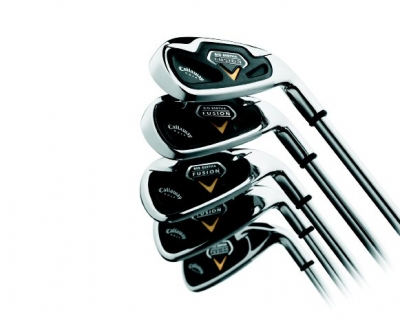 |
| The Callaway Big Bertha Fusion Irons. |
For the folks at Callaway Golf, however, they’re going to continue to look at the big picture, focusing on making everyone better. They’re not hiding the fact that they spend millions every season sponsoring the likes of Phil Mickelson and Annika Sorenstam to play and promote their goods – and also proudly proclaim that those products helped propel their professional Tour staff players to victories in five of eight professional majors (men’s and women’s) in 2005.
Callaway’s just as involved as its manufacturer colleagues in defending technology against the naysayers. As a maker of golf balls as well as golf clubs, they’re receiving the same amount of heat (if not more) than their cohorts. Yet, they’re out in the forefront of defending what it’s really all about – making us better.
When asked if there’s more room within the guidelines to keep making drivers, irons and balls that perform better, the short answer is yes. “Every golfer has their own definition of what would be ‘better’ for them, and the overwhelming majority of us are in no danger of threatening golf course architecture,” said Alan Hocknell, Senior Director of Product Design and Engineering at Callaway Golf.
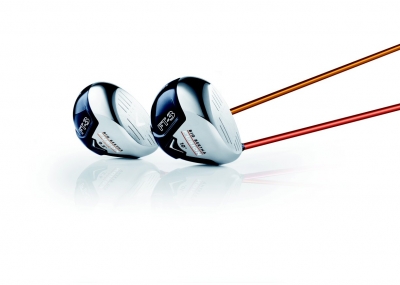 |
| The Callaway Big Bertha Fusion FT-3 Driver. |
Hocknell continues, “We need to understand individual golfers and apply our knowledge, creativity, science and construction technology to enabling these people to enjoy more golf.”
Having enjoyed a fair amount of golf myself, and played with a representative sample of the golfing public, Hocknell’s absolutely right. Don’t know if there’s a better way to put it – most of us are flat out bad. It depends on everyone’s individual expectations, but to find a player whose game consistency rivals what you see on TV… it just doesn’t happen very often.
To be fair, every company works towards the ‘better’ goal, and the golf manufacturing sector is not immune to specialization – someone’s always trying to make something that will help some golfer take less strokes. But two of Callaway’s recent products are specifically designed with ‘better-ness’ in mind, the Big Bertha Fusion Irons, and its FT-3 Driver.
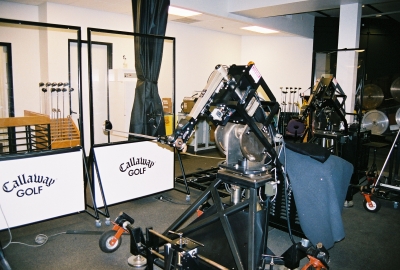 |
| Callaway's version of 'Iron Byron' puts all the computer theories to the practical test. |
Hocknell helps us distinguish them from their predecessors: “Both of these clubs stretch our multi-material ‘Fusion’ technology further, primarily to provide increased forgiveness on miss-hit shots. In the case of the FT-3 driver, we can position approximately one quarter of the total head weight on the perimeter, which stabilizes the head during impact and improves ball speed and direction on off-center shots.”
“In the case of the Big Bertha Fusion Irons (BB Fusion Irons), we use the proprietary Tunite material, a very dense, heavy metal developed here at Callaway Golf, to position the center of gravity very low in the head. That, in tandem with the wider sole, makes it extremely easy to get the ball up in the air. In addition, the Sensert material in the cavity is tuned to provide pleasing feel from all types of impacts,” Hocknell explained.
It’s amazing that in an era where everyone is introducing new products at the speed of marketing sound that anyone’s able to achieve true product differentiation, but Callaway’s products just look distinct. Ever since hitting a Big Bertha driver for the first time many years ago, there’s a certain level of confidence that goes with playing these clubs. Maybe it’s because you know that the technological ‘stuff’ is in them, but it’s also remembering that it was Ely Callaway’s mission to make the game more fun.
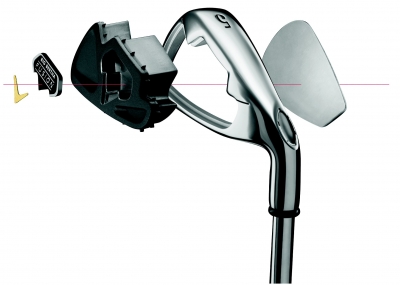 |
| This graphic demonstrates how several parts and different materials comprise the Big Bertha Fusion Irons. |
Arnold Palmer is the company’s senior spokesman these days, and he’s on the record for saying that technology is great for helping all of us to enjoy the game more. Just don’t get him started with talking about technology and those in the pro ranks.
But can we trust that the BB Fusion Irons and FT-3 are really better than what came before? Hocknell says they are. “Test data and computer simulations show the driver is hotter and straighter than its predecessor and is configured to appeal to all types of golfers. Similarly, the irons are the most forgiving Callaway has ever made.”
Having toured the Callaway R & D facility in 2004, I’ll attest to the fact they’ve got the proper equipment to assess these things, including an ‘Iron Byron’ machine and all the launch monitors you’d find in a golf science fiction movie. Always moving forward, you’ve got to think these are better, if incrementally, from the older models.
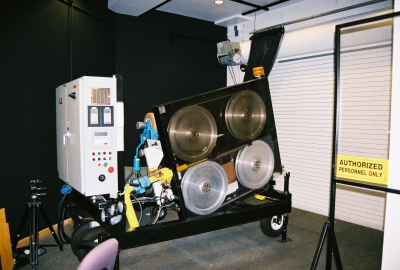 |
| This is a golf ball launching machine, which allows for measuring ball flight under different speeds and spin rates. |
But is the improvement due to materials or pure computer research?
“We choose materials to perform very specific functions in the head,” Hocknell answers. “Our core design philosophy is to move weight from where it is useless to where it is useful. Using several materials in concert with each other allows us to do this more effectively than ever before.”
“In contrast, when using a single material the design team is forced to make more compromises than is the case using multiple materials. The exact balance of the different materials changes with club type and by player type, and we are still learning how to optimize this science across the whole product range,” Hocknell added.
 |
| Here's what the FT-3 looks like on the inside. |
Hocknell’s candid admission that they’re still learning means Callaway is humble as well as capable. That’s good to know, especially since the company’s products aren’t exactly inexpensive. Claiming perfection and then not delivering would make a lot of people mad, even if the problem is more likely with the operator, not the vehicle.
Still, with golf equipment at this level, you wonder if the benefits translate as well to the recreational player as they do to Mickelson and Sorenstam. Hocknell insists they do. “The FT-3 is designed such that there is a club in the range for everyone – the best players and average players alike. The club was very successful on Tour last season, yet the women’s High Trajectory model is one of the most popular sellers.”
“Fusion technology in general allows us the design flexibility to build in features for different player types. In the case of the BB Fusion Irons, we could not have made such a forgiving and good-feeling wide soled iron for the less confident player without using the combination of high density, low density and soft materials found in that club head,” Hocknell said.
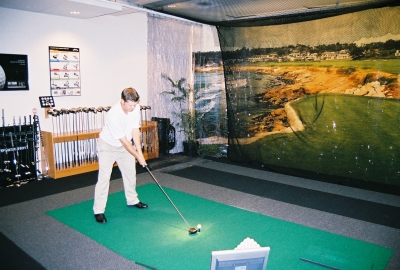 |
| Callaway's Carlsbad R & D facility includes a state-of-the-art fitting center, where you'll discover which clubs and golf balls are best for you. |
One ‘big’ departure with the FT-3 club from the earlier ERC Fusion model is size. There’s more of it with the latest club. Again, Hocknell cites weight distribution for the move towards the maximum 460cc dimension, re-stating that it’s preferable to position weight as far as possible from the center of the club head. This drives the total volume of the head up to the maximum (460cc) allowable within the rules.
The FT-3 driver design, with the Fusion technology, allows placement of a high percentage of the total weight in the perimeter of the head, and this is the FT-3’s key advantage over conventional all-titanium driver heads, which allow for significantly less flexibility.
The bigger head and larger sweet spot adds that much more confidence as well.
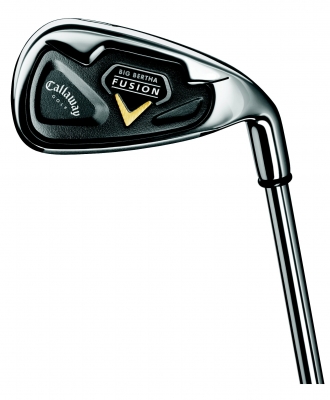 |
| Not exactly your traditional look, but attractive in its own right. |
All of this means nothing unless the club’s properly fit for you. Specialization in 2006 means more than just picking a name off a shelf. If you’re paying the money, get the most out of it. Callaway recommends doing your homework before buying, and suggests starting with their website to discover each club’s features and benefits. Then find a way to try the clubs on the golf course, where the benefits of the technology are most noticeable. Slashing away on a range or at an indoor hitting bay won’t really show what the clubs can do when confronted with real-life situations.
Personally, I found there’s truth in the advertising. The BB Fusion Irons were certainly as forgiving as any I’ve played in a long time, meaning they’ll move the ball towards the target without a lot of destructive deviation – no matter where I’d hit it on the club face. The large hitting surfaces breed confidence, though it was a bit more difficult to determine exactly where the sweet spot was than on other models (note: not that I’d be able to consistently hit it).
They appear quite large at address, and have changed my mind on the merits of oversized irons. I’ve always preferred more of the traditional look in irons, and while I’d say that’s still the case, the oversized appearance of the BB Fusion irons wasn’t unwelcome. For those seeking a big, forgiving iron, I’d certainly recommend trying them.
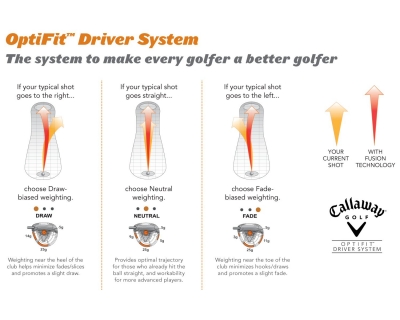 |
| Callaway's OptiFit Driver System helps point you in the right direction when trying to decide which club to choose. |
The FT-3 is indisputably a very easy-to-hit driver. When purchasing the club, you can specify whether you want a fade, draw or neutral bias. I chose draw to help out with some recent slice problems, and it certainly helped straighten out the flight. No driver will help if your clubface is open or closed at impact, but the best measure of whether a driver does what it says it will do is through the flight of the ball. Here, the FT-3 passes the test well.
Its large size makes it friendly to all levels of golfers, as I found out when I lent the FT-3 to a youth player several times during a round, only to receive a wide smile and a flurry of fist-pumps as he knocked it a good distance down the fairway on nearly every occasion. While it’s doubtful that the 45” stiff-flex shaft was the right one for him, making good contact with the 460cc head was all he needed to be satisfied. Conclusion – this is a very friendly club. Try it.
Is the FT-3 the longest club out there? Or the BB Fusion Irons the most forgiving? I can’t say. And Hocknell says it’s not always about claims of length and forgiveness. “We strive to make every golfer better. Claims of ‘longest’ and ‘best performing’ are often full of caveats and are an over-simplification. A simple selling message is attractive but the truth is, buying the right club for you has become a more sophisticated process than in the past.”
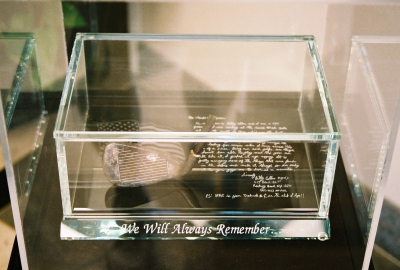 |
| This display in Callaway's main lobby puts it all in perspective. A Callaway iron head was found in the rubble at the World Trade Center, and returned to the company by the NYFD. |
“Callaway spends millions of dollars every year on R & D, and we try to build as much of the knowledge we generate into our club designs as possible,” Hocknell continued. “Golfers should trust that something designed by Callaway has all of that knowledge behind it and experience the benefits for themselves by testing our newest clubs.”
It can’t hurt, because when it comes to the game of golf, everyone is just hoping to get better.
Note: Our thanks to Mr. Ford Malmin of Palm Beach, Florida and Mr. Terry Michaels of Chicago, Illinois, who contributed impressions of the FT-3 Driver.
Details:
Callaway Big Bertha Fusion Irons and FT-3 Driver
Available at your higher-end golf retailers and club pro shops.
| Related Links | Comments on this article? | |
|
Maryland National Golf Club Hollow Creek Golf Club Rocky Gap Resort PB Dye Golf Club in Ijamsville Whiskey Creek Golf Club |
E-mail Jeff Rendall, Editor: jrendall@golftheunitedstates.com |













